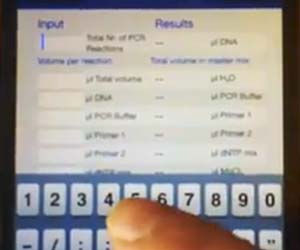Pipetting with Your iPhone?
by
 “Set timer for ten minutes.” Instead of the kitchen timers the rest of us use, the post-doc sitting behind me regularly uses Siri to time his experiments. As it turns out, it’s actually easier to tell a computer to set a timer for you than to do it yourself, and Siri is quickly becoming our lab’s newest research assistant. With a new iPhone model out each year, it’s not hard to believe that we’ll soon have everything we need on the little 2¼” x 4¾” device we can no longer go anywhere without. But what does that mean for us lab rats? And how can we leverage new technology to save us some time (something none of us ever have enough of)?
“Set timer for ten minutes.” Instead of the kitchen timers the rest of us use, the post-doc sitting behind me regularly uses Siri to time his experiments. As it turns out, it’s actually easier to tell a computer to set a timer for you than to do it yourself, and Siri is quickly becoming our lab’s newest research assistant. With a new iPhone model out each year, it’s not hard to believe that we’ll soon have everything we need on the little 2¼” x 4¾” device we can no longer go anywhere without. But what does that mean for us lab rats? And how can we leverage new technology to save us some time (something none of us ever have enough of)?
When I ditched my old Pantech keyboard phone for an iPhone 4 in 2010, I didn’t realize how much it would affect my lab life. Along with email, Google, Facebook, and HD cameras, smartphones also have the ability to put scientific tools at our fingertips.
In the five years I’ve been in graduate school, smartphones have become an everyday item — even not-so-tech-savvy PIs have the latest iPhone — and apps have evolved to the point where scientists now have their favorite tools all in one place. I can access and search journal articles using PubMed on Tap, view the latest edition of Cell on the Cell Press Journal Reader app, and count GFP-expressing cells using a tally counter app — all while streaming my favorite 90’s Pandora station.
Although my computer is only a pipette’s throw away, I can usually find what I need using my iPhone with less work sitting at the bench in the middle of an experiment. Take Life Technologies’ Cloning Bench app as an example. Every calculator I would ever need is provided on a spinning wheel selector tool. With up to six different PCR reactions running at the same time, I can easily automate my workflow and save time. Similarly, I can design a restriction digest using New England Biolabs’ Restriction Enzyme Double Digest Finder without having to leave the bench. In the past, when I have a new student in the lab learning basic lab techniques, I typically referred them to Abcam’s website. Now, protocols for ELISA, IHC, and Western Blotting, among others, are all available with a couple touches on their app. In addition to experimental tools, there are also multiple apps with classroom potential for science-related learning. Exploring 3D animal and plant cells, signaling pathway overviews, and 3D protein structure modeling are just the beginning.
In addition to experimental tools as apps, we’re even turning smartphones into pieces of lab equipment. Want your own personal microscope? Done. Turning your iPhone into a microscope with up to 175X magnification is relatively simple according to this instructional video. We’ve incorporated this functionality in our lab for a measly $70: instead of spending hundreds of dollars on a new lens for our dissecting microscope, we bought a lens adaptor (ōlloclip®) that clips onto an iPhone lens, increasing the available magnification of the existing camera (and mobility) for a fraction of the cost.
While I firmly believe there is always the place for the traditional — I still prefer to read papers as hard copies — the milieu of smartphone tools available to facilitate the basics of experimentation is amazing. While the apps are often the same web tools that have long been available, they’re now conveniently located (literally) in your back pocket on one device you can take anywhere.
Although there is merit in decreasing smartphone use in favor of more personal interactions, overall I think the arguments for using smartphones to enhance your lab experience are good. Many of the tools I’ve mentioned still require basic knowledge of why and how the technique involved is used. Therefore, these shortcuts are not intellectual ones, but rather time-savers. Between working 11-hour days just to have experiments fail and trying to convince your PI that IpromiseI’mworkingeventhoughIdon’thaveanyfiguresyet, being a graduate student is hard enough. If being tethered to my iPhone in lab means finishing my experiment a half hour early because it took less time to set it up, I’ll take it.
So what’s next? Will smartphone technology eventually negate scientific products and the businesses that supply them? (Remember the Flip video camera?)
What smartphone tools do you use in lab? How have smartphones changed your lab experience? Head over to Google+ and let us know.
Emily is a fifth year graduate student here to explore firsthand how technology and video can enhance your research experience. As scientists, we are on the cutting edge of new technologies that can take our work to the next level and allow us to find solutions to questions that were previously unanswerable. Let’s make use of the new and shape the future.

